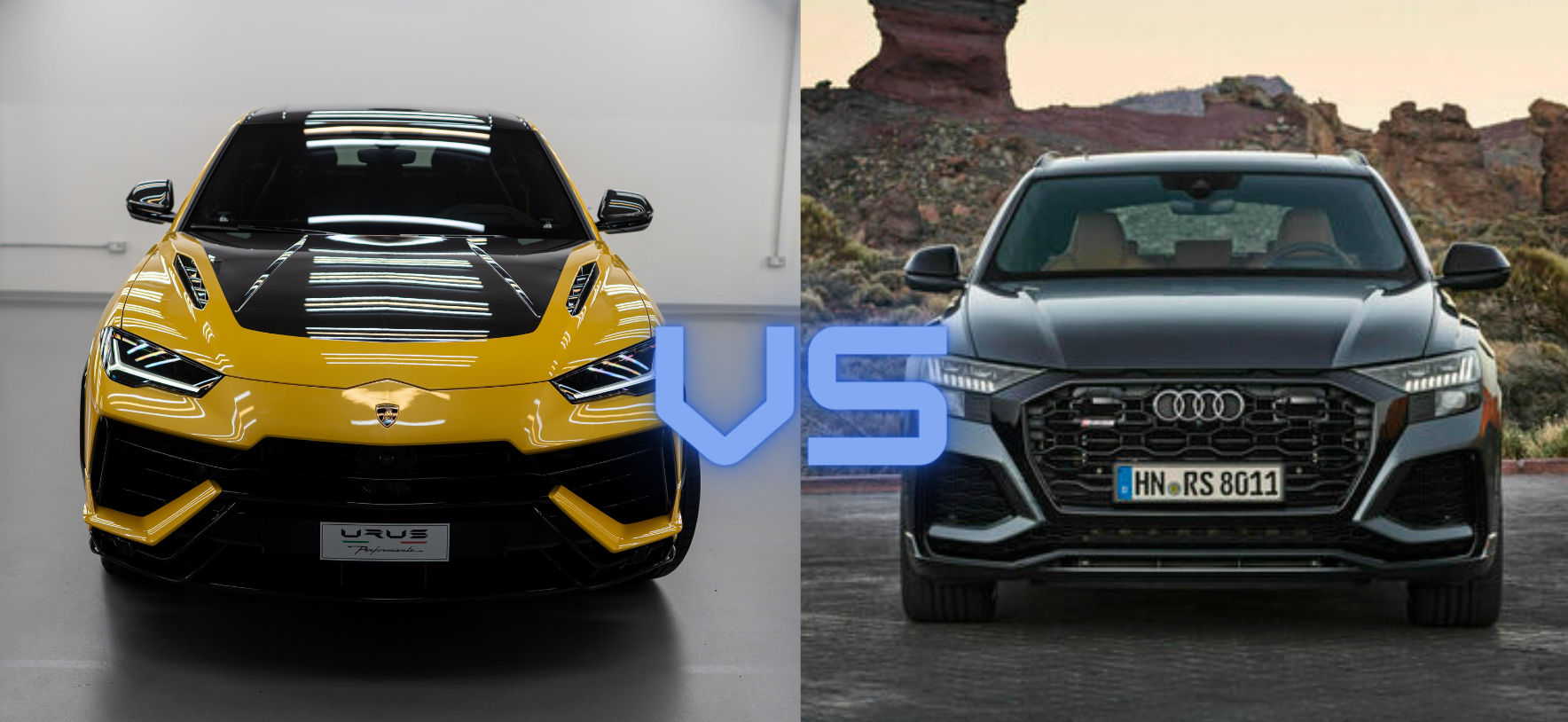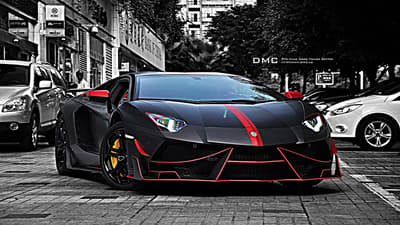In the sprawling empire of the automobile world, few conglomerates have captured as many high-end sub-brands as the Volkswagen Group. Among these luxury marques are Audi and Lamborghini – two brands with legacies that blend innovation with luxury, and, in recent years, both have ventured into the realm of luxury sports SUVs. With the Lamborghini Urus and the Audi RS Q8, the world witnessed the birth of two titanic SUVs with more in common than meets the eye.
A journey down memory lane takes us to the 2012 Beijing Auto Show, where Lamborghini unveiled its compelling vision of a super SUV – the Urus concept. It took six years for this vision to manifest into reality, with the global market welcoming the Urus in 2018. Not to be left behind, Audi, with its own racing pedigree and luxury heritage, showcased its contender, the RS Q8 concept, in January 2017. By March 2019, the model had made its grand entrance.
There’s an inherent curiosity about cars under the Volkswagen umbrella. How much do they borrow from each other? Do they maintain their distinct identities?
The Lamborghini Urus and the Audi Q8 are exciting case studies. They don’t mirror each other in exteriors, yet the foundation they’re built upon – the platform – is shared. Lamborghini has seasoned the Urus with its characteristic audacity, sharp, aggressive lines on the outside, and an interior that echoes the brand’s flamboyance.
Peek under their hoods and the family resemblance becomes more apparent. Both SUVs are powered by a V8 twin-turbo engine, augmented by features like 4-wheel steering, adjustable air suspension, an active rear differential, active electromechanical anti-roll bars, and the stopping power of carbon-ceramic brakes. The RS Q8 goes further, integrating a Biturbo with a mild-hybrid setup, generating an impressive 591 HP and 590 lb-ft of torque. The Urus, embodying the Lamborghini spirit, pumps the same engine to a ferocious 641 HP and 627 lb-ft of torque, making it a beast in SUV clothing.
However, cars, especially those of this caliber, aren’t just about numbers. The Lamborghini Urus, crowned the fastest production SUV, undoubtedly has enthusiasts and purists swooning. Yet, its lofty price tag brings along expectations – and here, there are some nuances, like the omission of features such as radar cruise control.
This article looks at these two vehicles, comparing them across various aspects such as performance, design, interior, technology, and value.
Audi RS Q8 vs Lamborghini Urus: Design Philosophy
Quick Summary: The Lamborghini Urus exudes raw power and aggressiveness, staying true to its bull mascot with sharp contours and commanding features. It’s a head-turner, demanding attention wherever it roams. On the flip side, the Audi RS Q8 offers understated power. While similar to the regular Q8, subtle design enhancements hint at its latent strength. Unlike the attention-grabbing Urus, it’s ideal for those who prefer their high-performance vehicles to be discreet, allowing for less conspicuous parking and daily use.
Lamborghini Urus
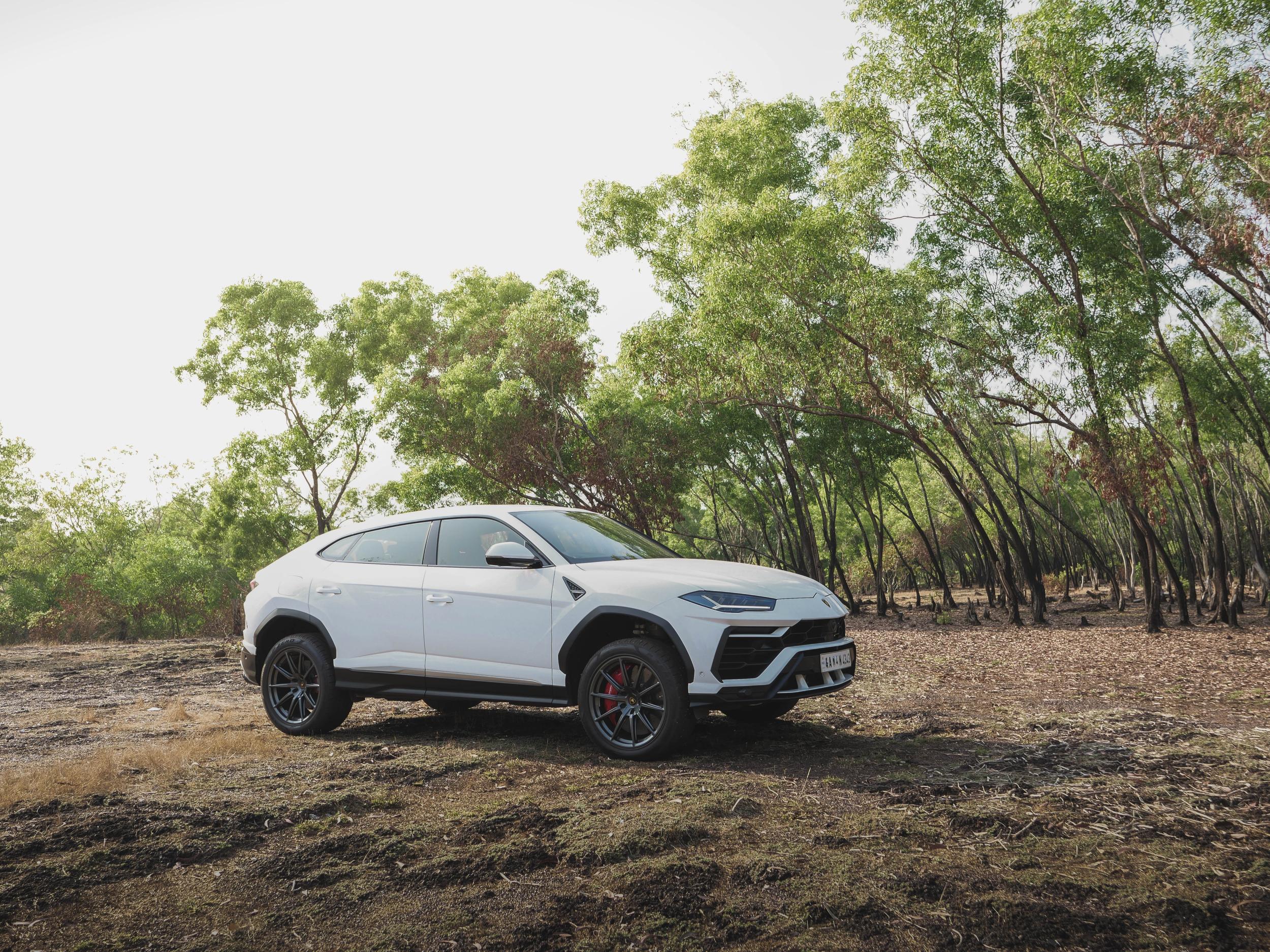
Every Lamborghini tells a story of raw power, and it’s no surprise that their emblematic bull symbolizes unbridled strength. The Urus is a testament to this legacy. Its razor-sharp contours, dominating presence, and design cues scream aggressiveness, especially in the fierce headlamps and assertive nose. Broad rear haunches and wheels are nestled within squared arches, crafting a fusion of sleekness with the odd curvature.
The tail light, a masterpiece in design, spans seamlessly across the tailgate, captivating onlookers. The integrated spoiler, dynamic diffuser, and commanding vents add flair to its sporty silhouette.
Audi RS Q8
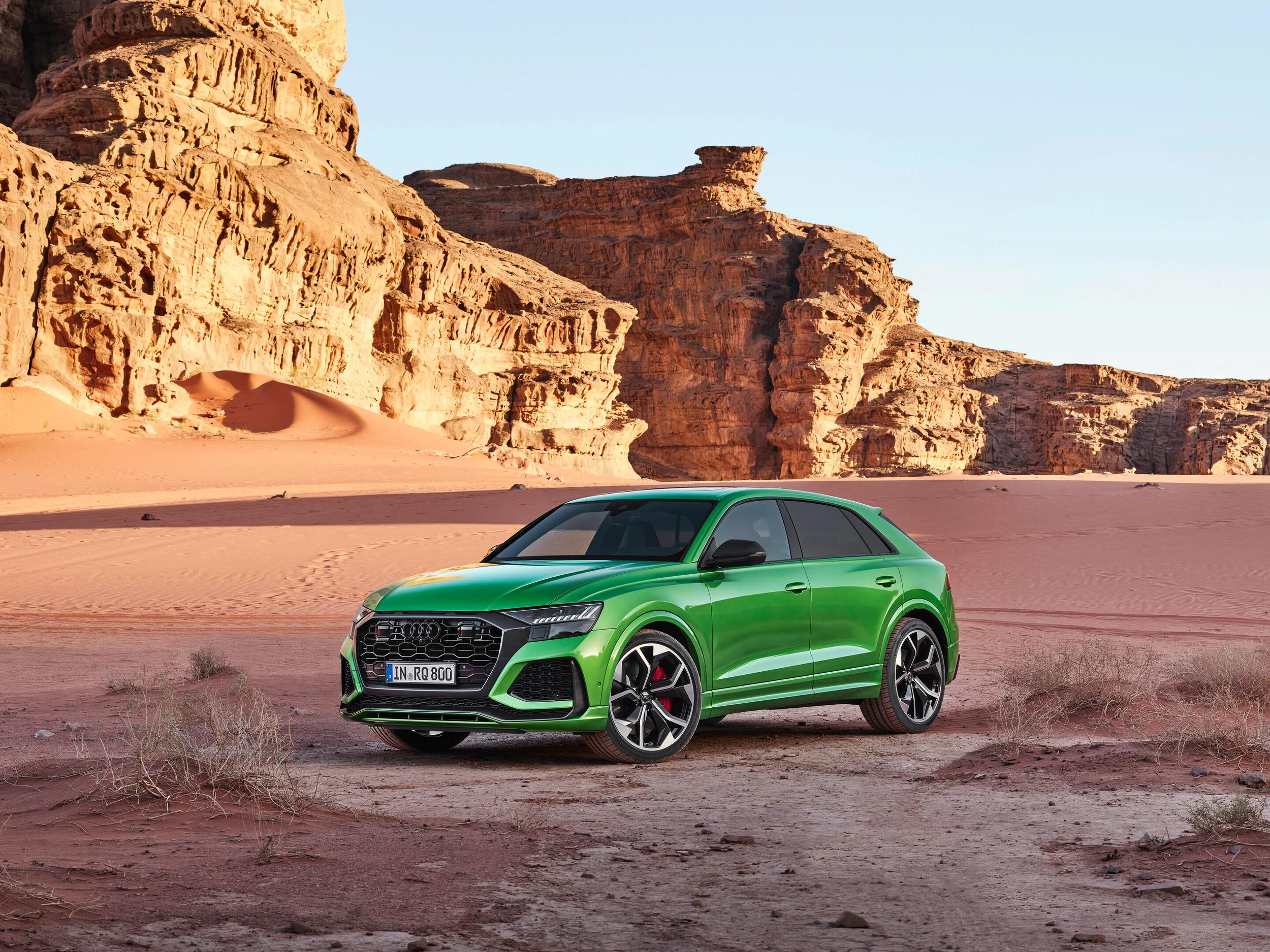
The RS Q8 showcases a different kind of vehicular philosophy. It greets you with pronounced vents, a signature honeycomb grille, angular headlamps, and a deliberate splitter. Elements like carbon mirror caps and a lowered stance hint at its prowess. Side by side with the Urus, the RS Q8 might seem more subdued, but that’s its strength. It’s a wolf in sheep’s clothing. At first glance, it may mirror the regular Q8, but those in the know will spot the enhanced brakes, exclusive wheels, and unmistakable RS badges.
Upgrades like enlarged vents, a refined diffuser, and a broader frame separate it from the standard Q8, making it the perfect choice for those who love a powerful machine with a discreet demeanor. One distinct advantage of the RS Q8? Its more muted appeal means you can park it in everyday locations, like a shopping parking lot, without drawing the excessive attention the show-stopping Urus inevitably attracts. With the Urus, its magnetism necessitates an extra layer of caution.
Audi RS Q8 vs Lamborghini Urus: Engine and performance
Quick Summary: The Lamborghini Urus and Audi RS Q8, sporting a V8 engine, showcase distinct characteristics. The Urus, fine-tuned by Italian engineers, produces a mammoth 657 hp and 627 lb-ft of torque, achieving 0 to 60 mph in 3.6 seconds with a top speed of 190 mph. In contrast, the RS Q8 from Audi, while brandishing a similar engine, offers a slightly less powerful 591 horsepower and 590 pound-feet of torque. It accelerates from 0 to 60 in 3.7 seconds, with an electronically limited top speed of 155 mph. Audi incorporates a 48-volt hybrid system for enhanced fuel efficiency in the RS Q8.
Lamborghini Urus
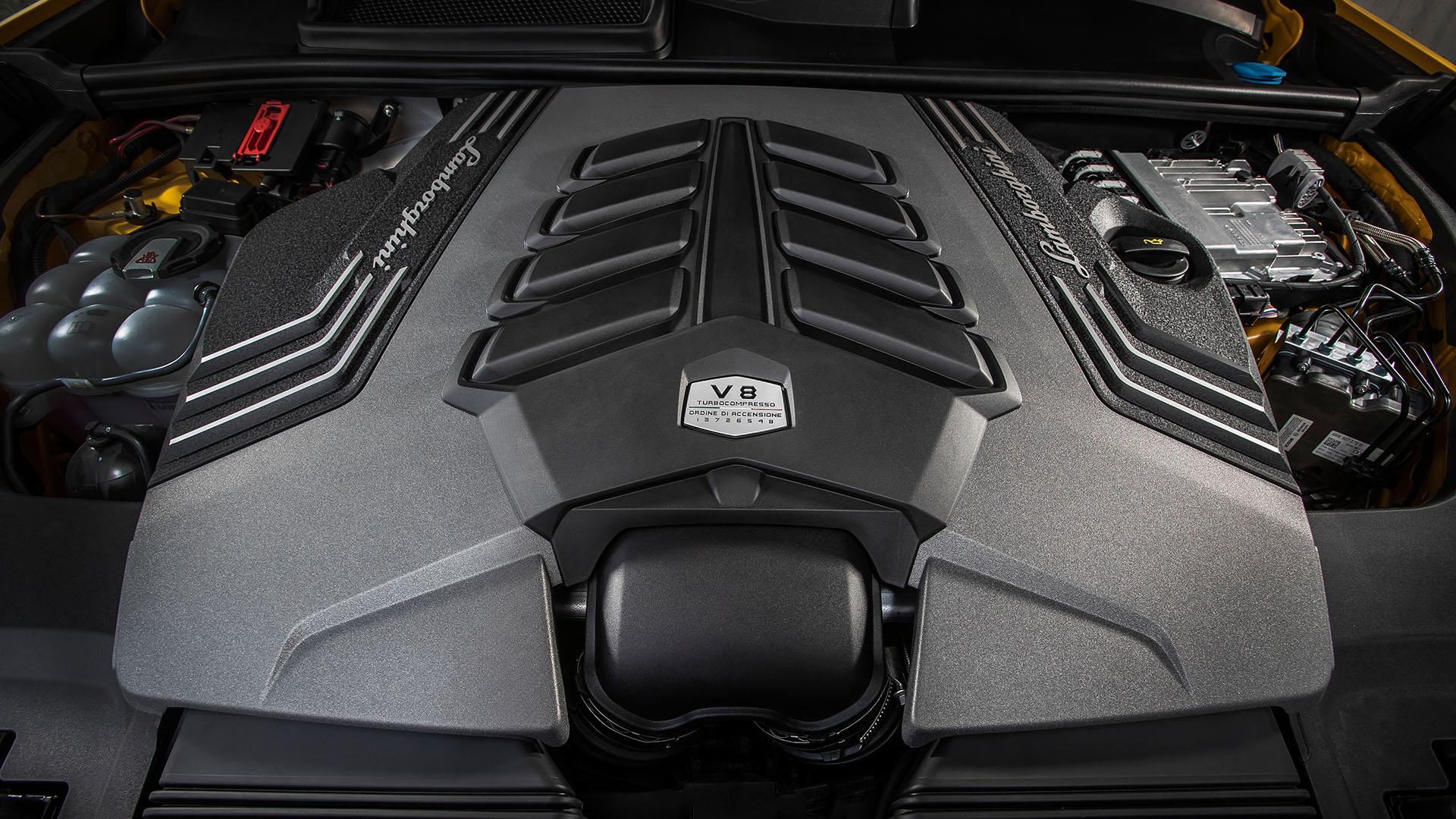
The Urus shares the same V8 engine with the RS Q8. However, the Italians have sprinkled their magic, fine-tuning this V8 powertrain distinctively from their German counterparts. The result? A staggering 657 hp and a torque of 627 lb-ft.
This robust concoction gives the Urus an enviable power-to-weight ratio and crowns it as the jewel in the SUV segment. Let’s talk numbers: 0 to 60 mph in a mere 3.6 seconds and a top speed that screams at 190 mph. And for those craving an adrenaline rush, the new Performante variant of the Urus sits 0.8 inches lower and boasts 104 pounds lighter than its standard sibling.
Audi RS Q8
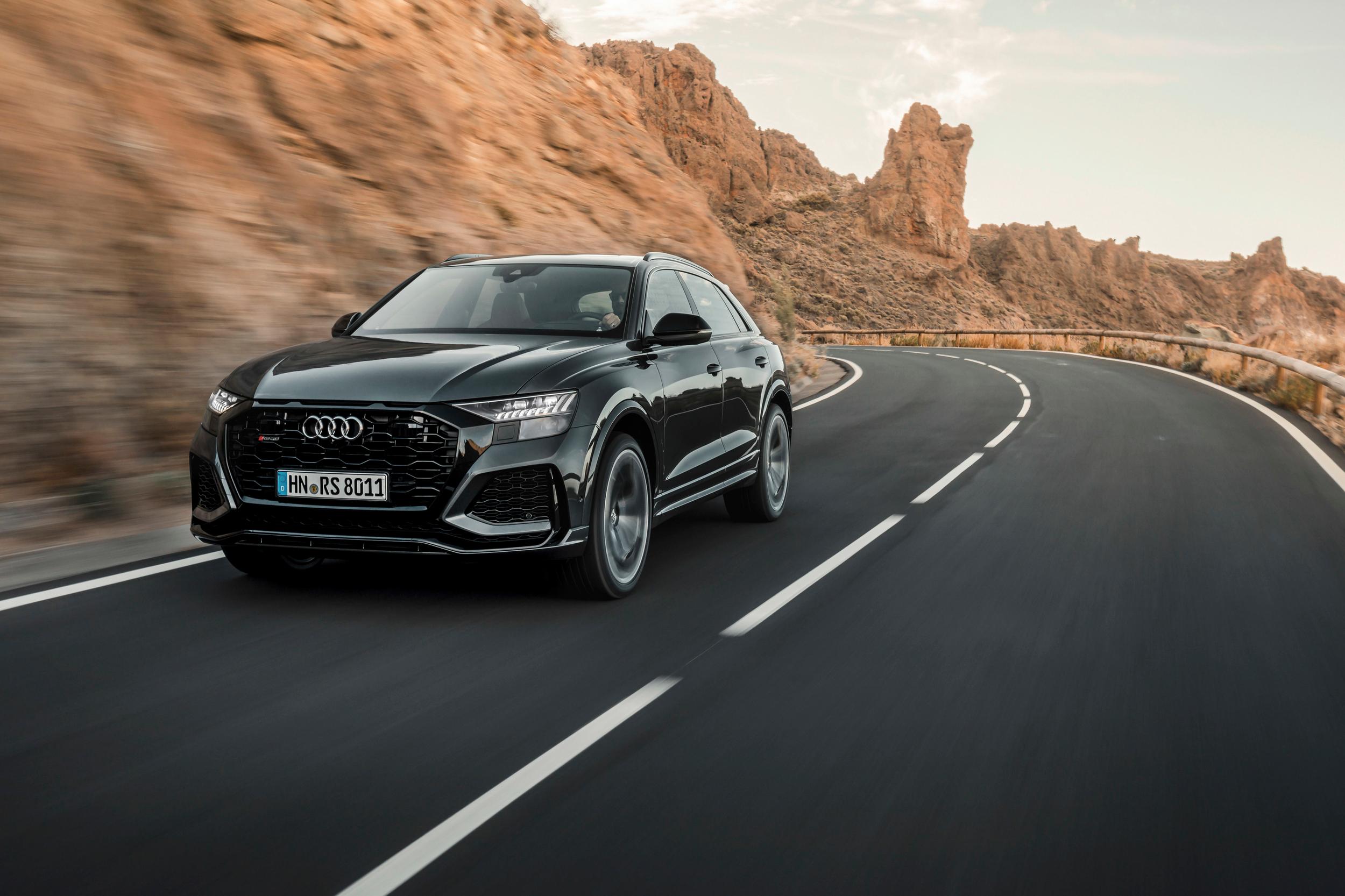
Audi’s RS emblem is synonymous with pinnacle performance. The RS Q8 isn’t just another SUV; it’s Audi’s crowning achievement atop its SUV throne. Underneath its hood roars a 4.0-liter twin-turbocharged V-8 engine, quite similar to its SQ8 kin, but with an evident difference: a mammoth 591 horsepower and 590 pound-feet of torque, overshadowing the SQ8’s 500 horsepower and 568 pound-feet. Seamless integration with the Quattro all-wheel drive and an eight-speed automatic transmission ensures smooth movement. But Audi didn’t stop there.
They infused a 48-volt hybrid system, subtly working in the shadows, enhancing fuel efficiency without compromising on performance. Racing from 0 to 60 in 3.7 seconds, the RS Q8 is nipping at the heels of the pricier Urus. And while it boasts a top speed of 155 mph, it’s electronically restrained, hinting at the beast that lurks within.
Specification
| Specification | Audi RS Q8 | Lamborghini Urus |
|---|---|---|
| Engine Type | 4.0L V8 Twin-Turbo | 4.0L V8 Twin-Turbo |
| Horsepower | 591 hp | 641 hp |
| Torque | 590 lb-ft | 627 lb-ft |
| Transmission | 8-speed automatic | 8-speed automatic |
| Drive Type | All-wheel drive (quattro) | All-wheel drive |
| 0-60 mph Time | 3.7 seconds | 3.6 seconds |
| Top Speed | 155 mph (limited) | 190 mph |
| Fuel Economy (city/hwy) | Around 13/19 mpg | Around 12/17 mpg |
| Curb Weight | 5,490 lbs | 4,850 lbs |
| Wheelbase | 117.9 inches | 118.2 inches |
| Length | 197.3 inches | 201.3 inches |
| Width | 78.7 inches | 79.4 inches |
| Height | 67.2 inches | 64.5 inches |
| Seating Capacity | 5 | 4 or 5 (depending on configuration) |
| Cargo Space | 30.5 cu ft (rear seats up) | 21.7 cu ft (rear seats up) |
| Suspension | Adaptive air suspension | Adaptive air suspension with active dampers |
| Brakes | Ventilated discs | Carbon-ceramic discs |
Audi RS Q8 vs Lamborghini Urus: Ride and handling
Quick Summary: Both the Lamborghini Urus and the Audi RS Q8 stand as titans in high-performance SUVs, each reflecting their brand’s ethos. The Lamborghini Urus, blending sportiness with luxury, employs an intricate mix of adaptive air suspension and active roll stabilization, offering a harmonious blend of comfort and agility. Performance-oriented tires and substantial carbon ceramic brakes (around 440mm) ensure grip and stopping power. At the same time, its Torsen center differential with a dynamic 40:60 split underscores adaptability in ever-changing driving conditions. Conversely, the Audi RS Q8 places its bets on a precise balance of sportiness and comfort. It boasts Audi’s renowned adaptive air suspension, enabling ride height adjustments across terrains.
Model-specific tires augment its agility, though their soft compound hints at quicker wear. The RS Q8’s quattro system, with a steadfast 40:60 split, promises consistent, albeit potentially less adaptable, performance. Its braking prowess is evidenced by discs often exceeding 420mm, yet their heft might slightly curb the SUV’s sprightliness. In the grand tapestry of high-performance SUVs, the Urus leans towards an adaptive, sportier demeanor, while the RS Q8 champions a harmonized blend of Audi’s hallmark performance and engineering. Both, however, signal a departure from the nimbleness inherent to dedicated sports cars, a natural trade-off of their SUV pedigree.
Lamborghini Urus
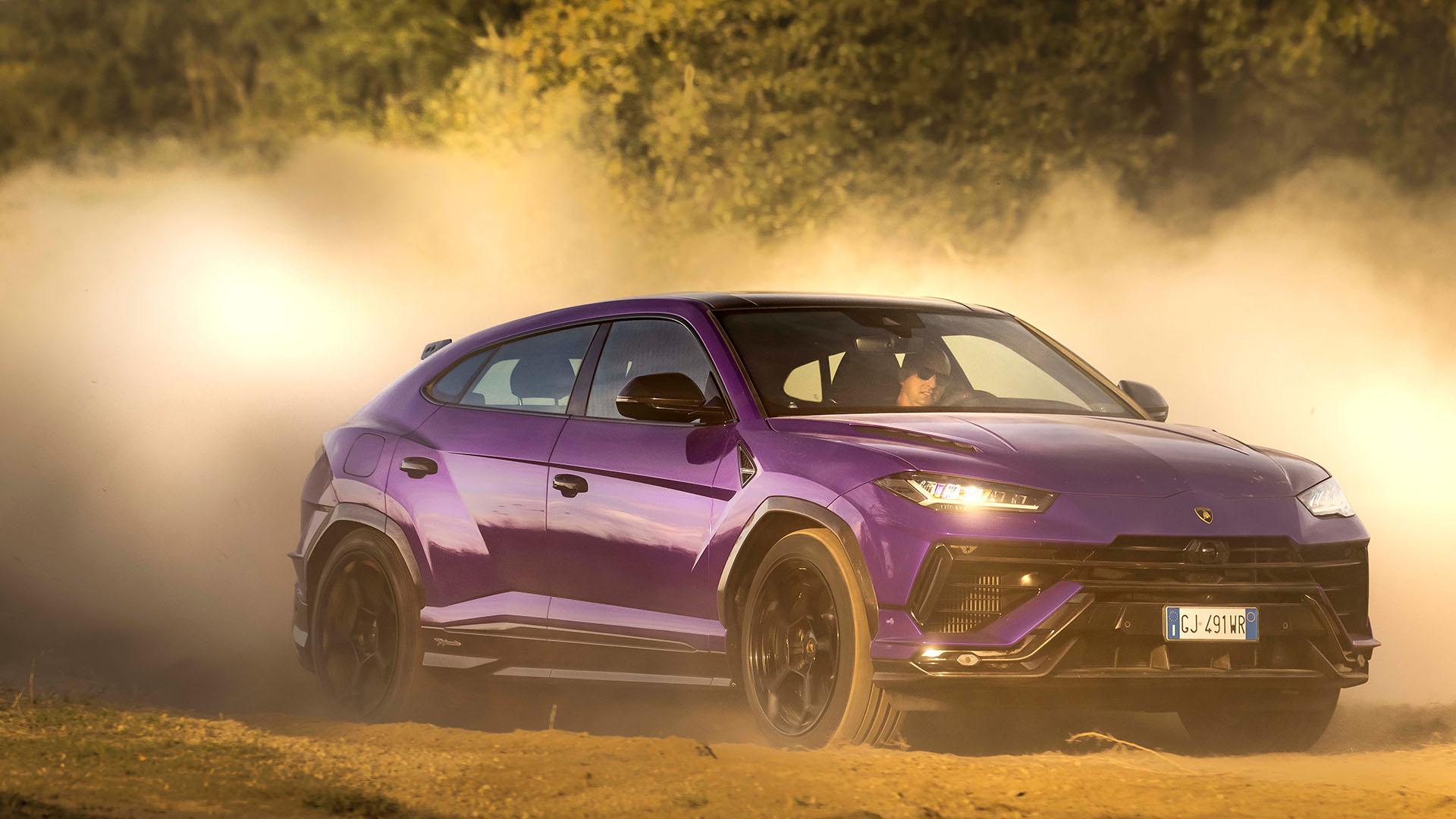
The Lamborghini Urus presents a mixed bag regarding its handling characteristics. On the positive side, it utilizes a state-of-the-art suspension system that combines an adaptive air suspension with active roll stabilization. This setup offers a comfortable and plush ride during everyday drives while delivering remarkable responsiveness when pushed to its limits on curvy roads or the track. The Urus also benefits from massive performance-oriented tires, providing a noteworthy grip that defies its substantial size and weight, allowing it to tackle corners with impressive agility.
However, there are some notable drawbacks. The sheer size and weight of the Urus limit its agility compared to traditional Lamborghini supercars. While it’s undoubtedly one of the more athletic SUVs available, it can’t quite match the skill of its sleeker siblings. Additionally, while offering phenomenal stopping power, the carbon ceramic brakes can be quite sensitive in everyday driving situations, requiring a delicate touch on the pedal to avoid abrupt stops.
Speaking of the technical details, the Urus features substantial carbon ceramic brakes, with front disc sizes typically measuring around 440 mm (17.3 inches) to ensure exceptional stopping power. As mentioned earlier, its suspension system combines an adaptive air suspension with active roll stabilization, striking a balance between comfort and performance.
The Urus also benefits from Lamborghini’s advanced all-wheel-drive system, which, while rooted in the Volkswagen Group’s technology, Lamborghini engineers have extensively developed and tuned to suit the brand’s high-performance requirements. The Lamborghini Urus offers a unique blend of comfort and performance. Still, its handling characteristics are inevitably influenced by its SUV nature and hefty curb weight despite the impressive technology.
Audi RS Q8
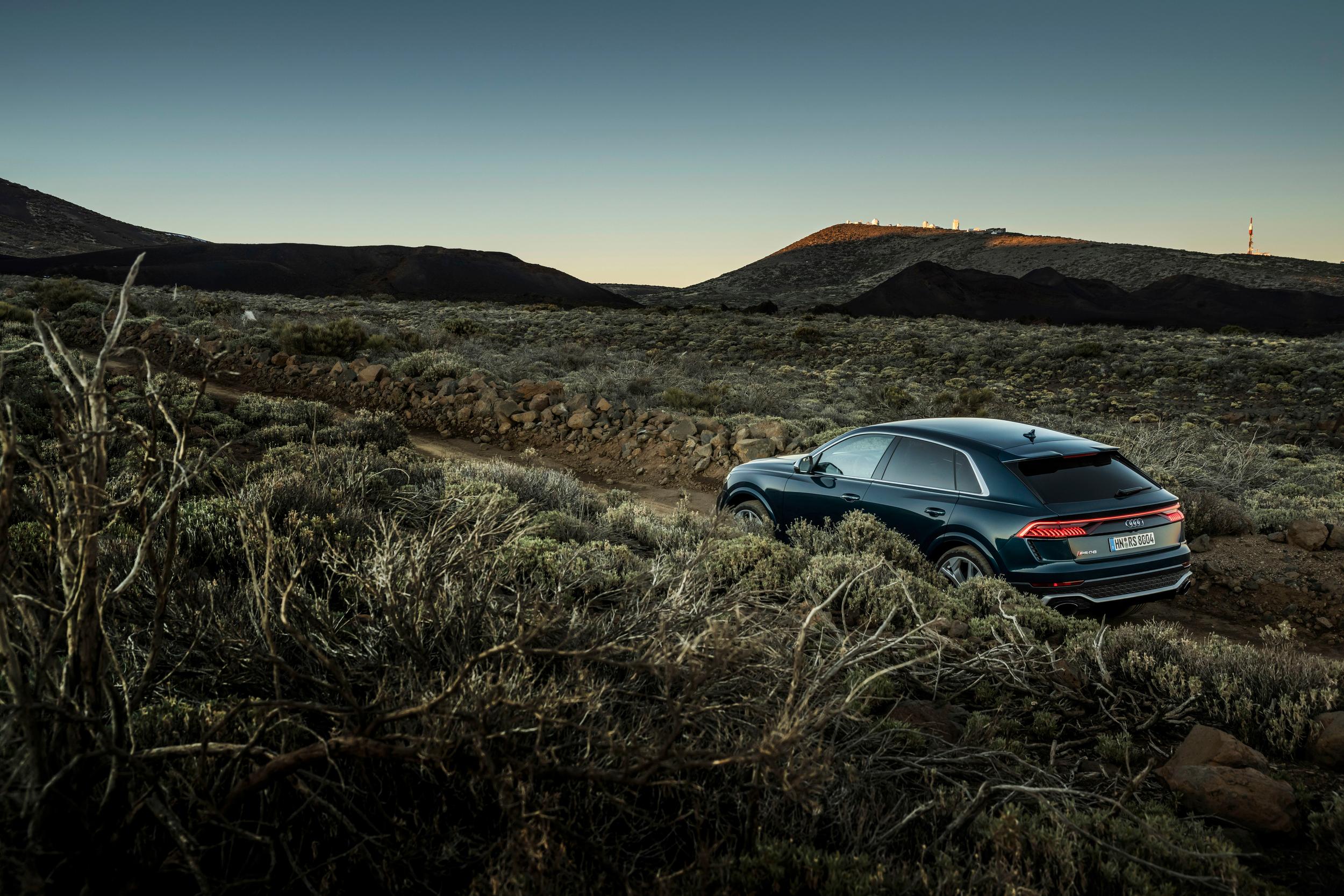
The Audi RSQ8 certainly establishes itself as a notable contender in the high-performance SUV arena, but, like all machines, it isn’t without its quirks. One of the RSQ8’s primary strengths lies in its well-engineered suspension setup—this setup, which includes Audi’s adaptive air suspension, balances sportiness and comfort. The RSQ8 can alter its ride height to accommodate different driving terrains, ensuring optimal grip and stability. While this feature offers significant advantages, some purists may argue it lacks the raw, ground-hugging feel of more traditional sport suspension setups.
The SUV’s standard quattro all-wheel-drive system is another highlight, delivering impressive traction. However, unlike the Lamborghini Urus, which utilizes a Torsen center differential with a 40:60 power split between front and rear, which can vary according to conditions, the RSQ8’s quattro system operates with a fixed 40:60 split. This means that while the RSQ8 offers consistent performance, the Urus has a slight edge in terms of adaptability in various conditions.
The RSQ8’s performance tires, specifically designed for the model, undoubtedly enhance its agility, promising superior grip in dry and wet terrains. Yet, it’s worth noting that these tires might wear out quicker than conventional ones due to their soft compound, necessitating frequent replacements for regular-spirited drivers.
One cannot discuss the RSQ8 without mentioning its formidable brakes. With front disc sizes often exceeding 420mm, they provide stellar stopping power, letting the SUV decelerate from high speeds with aplomb. However, those massive discs and calipers could add weight, somewhat affecting the car’s overall agility. In conclusion, while the Audi RSQ8 exemplifies Audi’s prowess in engineering and innovation, offering a refreshing drive and the practicality of an SUV, potential buyers should be aware of its nuances to ensure it aligns with their driving expectations.
Audi RS Q8 vs Lamborghini Urus: Interior
Quick Summary: The Audi RS Q8 and Lamborghini Urus, both premium SUVs, differentiate in how they project luxury and performance. Audi’s RS Q8 is emblematic of opulence, with its signature interiors dominated by suede leather and touch screens, radiating a sense of understated elegance.
In contrast, the Lamborghini Urus is a theatrical expression of luxury and sportiness. It draws inspiration from fighter jets with cockpit-like buttons, a throttle-resembling shifter, and dramatic Lamborghini design cues.
While both SUVs boast high-end tech features and amenities, the Lambo delivers a more audacious experience, and the RS Q8 leans more toward refined sophistication.
Audi RS Q8
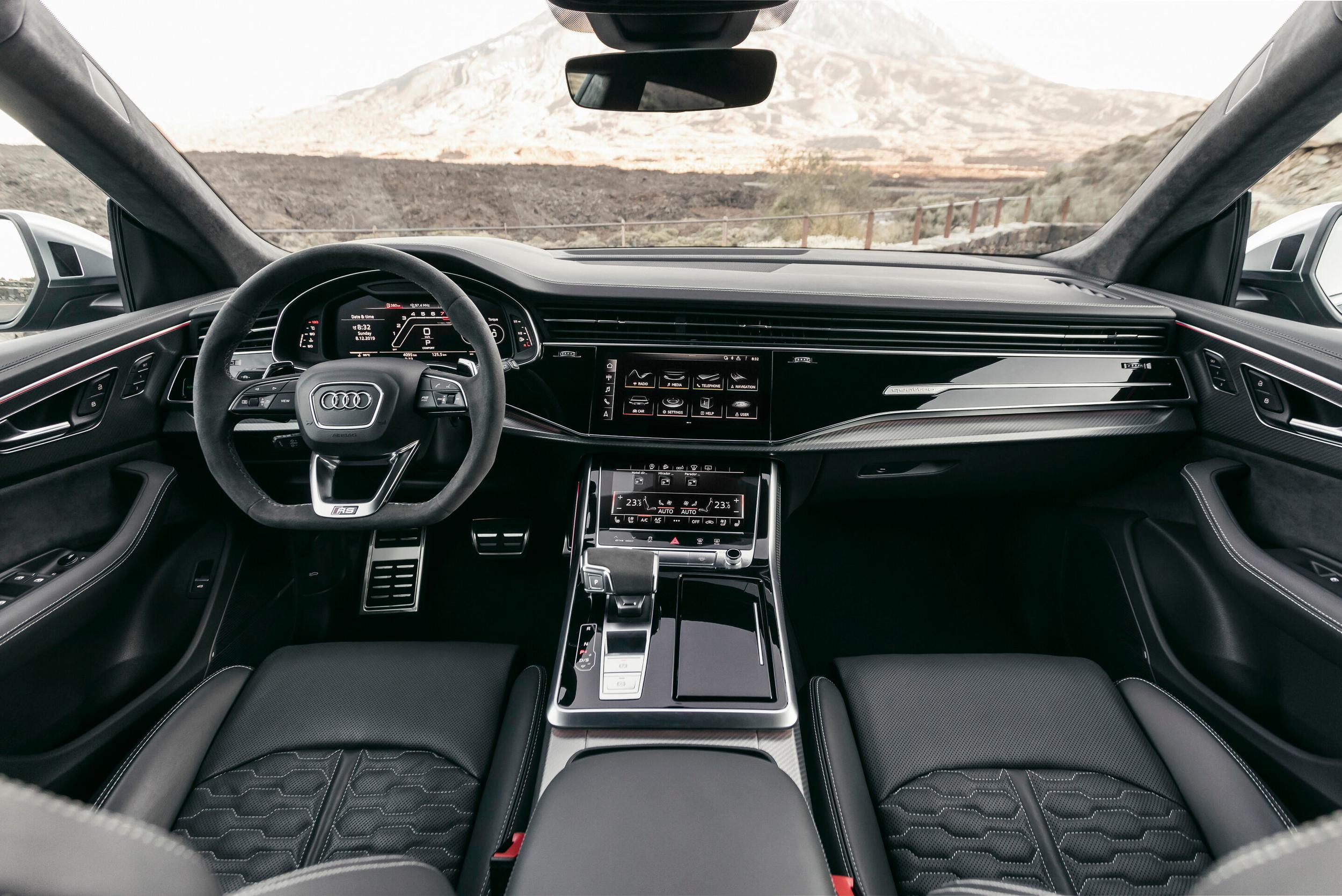
Audi sets a gold standard with its opulent interiors. Draped in sumptuous suede leather, the RS Q8 exudes luxury at every turn. The sleek flat-bottom steering, wrapped in Alcántara, offers a touch of extravagance. Echoing Audi’s signature style, the high-tech amenities in the RS Q8 are second to none. Touch screens entirely dominate the central console, enhancing its modern aesthetic.
Regarding the Lambo, its interiors make a bold statement immediately. Sporty vibes resonate with the spirited designs and vibrant colors of the gauges. Like the RS Q8, suede leather envelops the interiors, complementing the assertive flat-bottom steering. Lamborghini’s traditional plethora of buttons grace the central console, giving you a cockpit feel.
In the realm of high-end SUVs, Audi and Lamborghini are on par. The RS Q8 and the Urus boast comparable premium features – from top-tier audio systems and navigation to WiFi, touch infotainment displays, digital gauge clusters, and the luxury of heated seats for front and rear passengers.
Lamborghini Urus
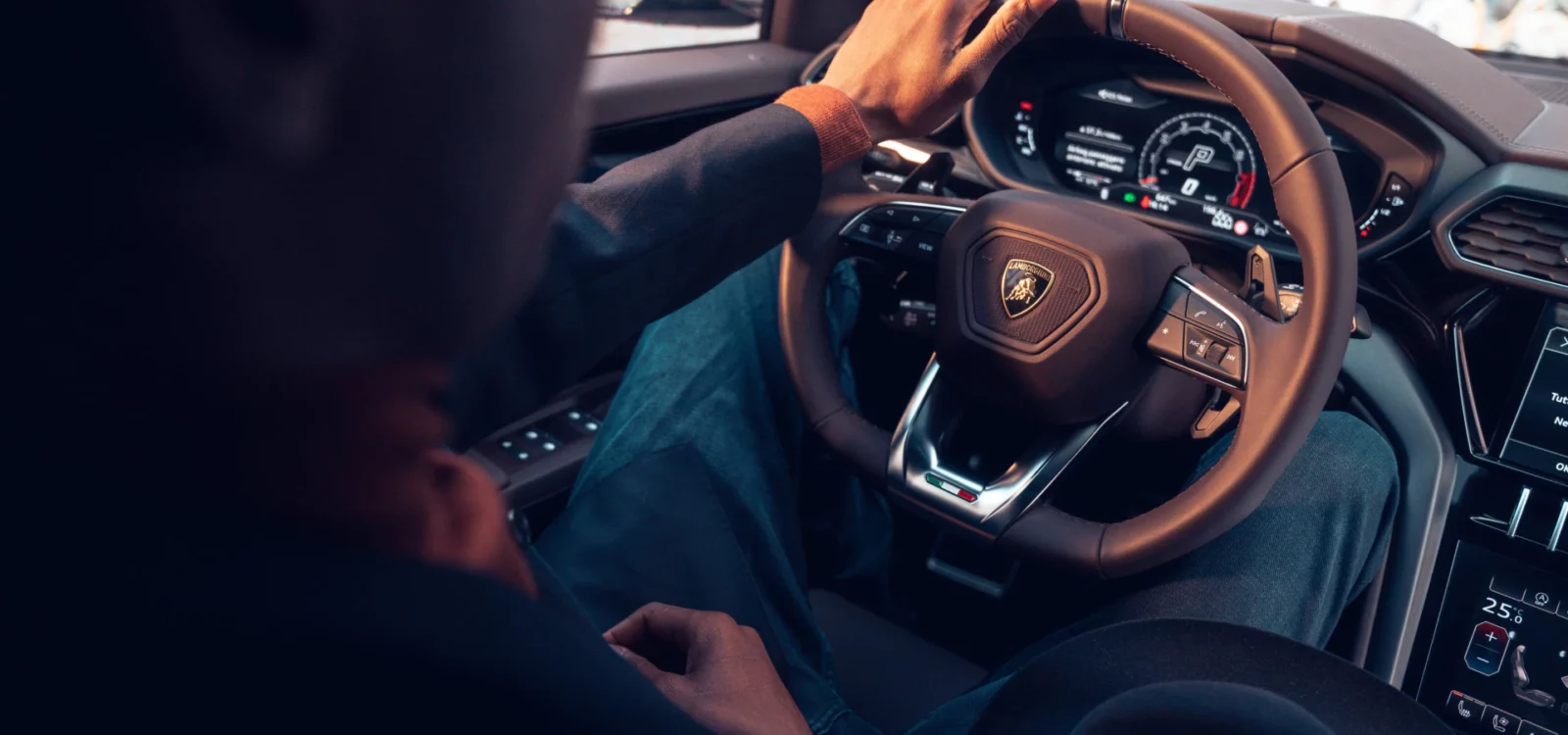
Step inside the Urus, and you’re instantly captivated by its quintessential Lamborghini flair. The interior is symbolic of a fighter jet, from the start button under a red protective flip cover to the throttle-like shifter. Adjacent to this are levers that tweak drive modes and optimize performance settings.
The cabin is adorned with faux-suede, carbon-fiber accents, and an infotainment system that could easily belong to an Audi sibling. The rear comfortably accommodates two or three, based on your seating choice, while door pockets and a storage bin behind the center stack optimize space.
The Urus boasts a sizable 22 cubic feet of cargo space, although this shrinks slightly with the selection of rear bucket seats. Tech-wise, the Urus is good. Beyond the fully digital gauge cluster, two touchscreen panels integrate seamlessly into the center stack, controlling climate, audio, and more. Their sharp graphics and large icons stand out, although they may take some getting used to for those fond of traditional knobs and buttons.
Audi RS Q8 vs Lamborghini Urus: TECHNOLOGY
AUDI RS Q8
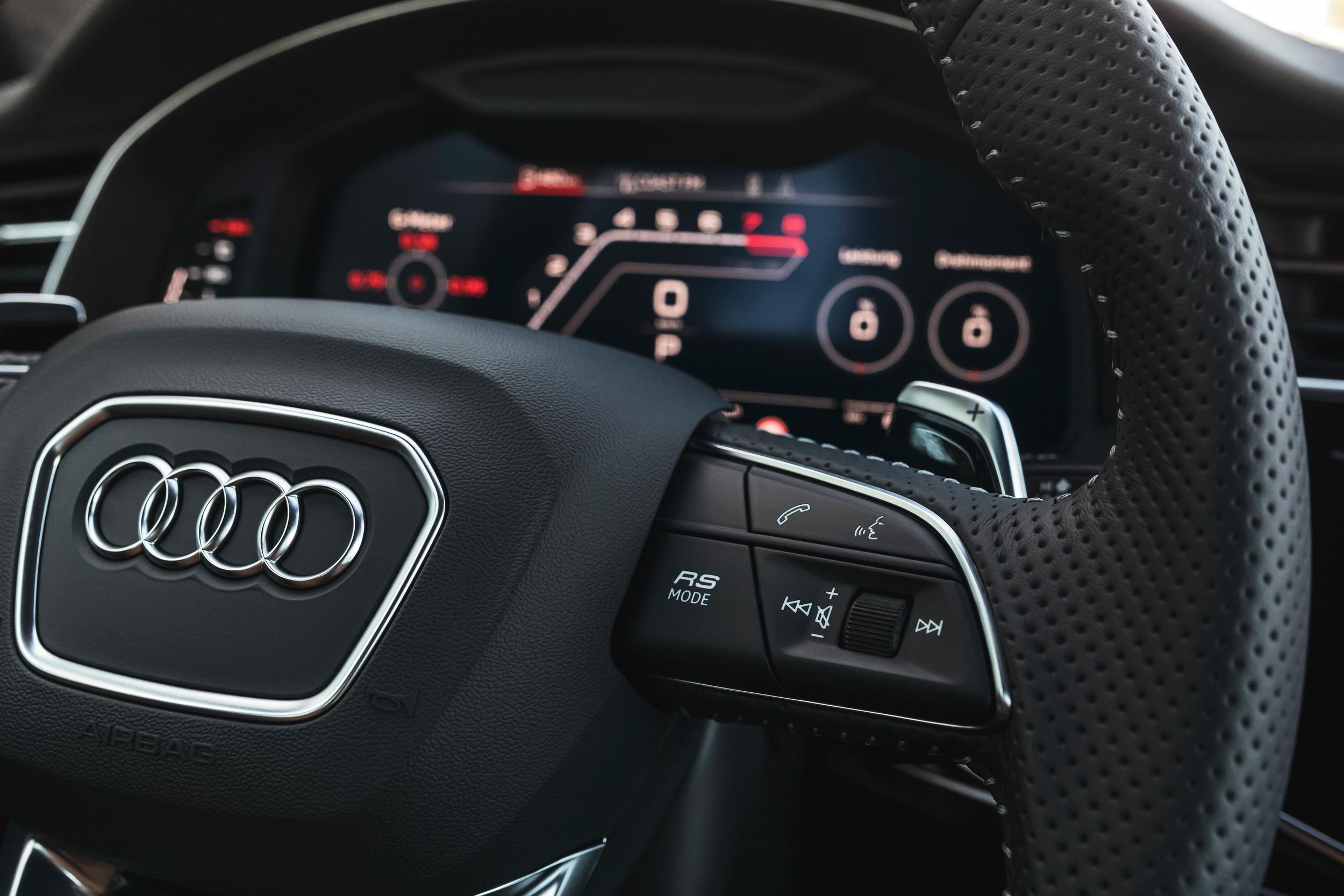
Audi’s Virtual Cockpit provides a customizable digital instrument display that can showcase everything from traditional gauges to total navigation views. With compatibility with Apple CarPlay and Android Auto, the infotainment system ensures seamless smartphone integration.
The RS Q8’s advanced driver-assistance systems are equally noteworthy. Features like adaptive cruise control, lane departure warning, and a 360-degree camera provide increased safety and comfort during driving. The adaptive headlights with matrix LED technology offer improved visibility without dazzling other road users.
An available Bang & Olufsen 3D Premium Sound System provides an immersive audio experience, turning the interior into a personal concert hall.
Lamborghini Urus
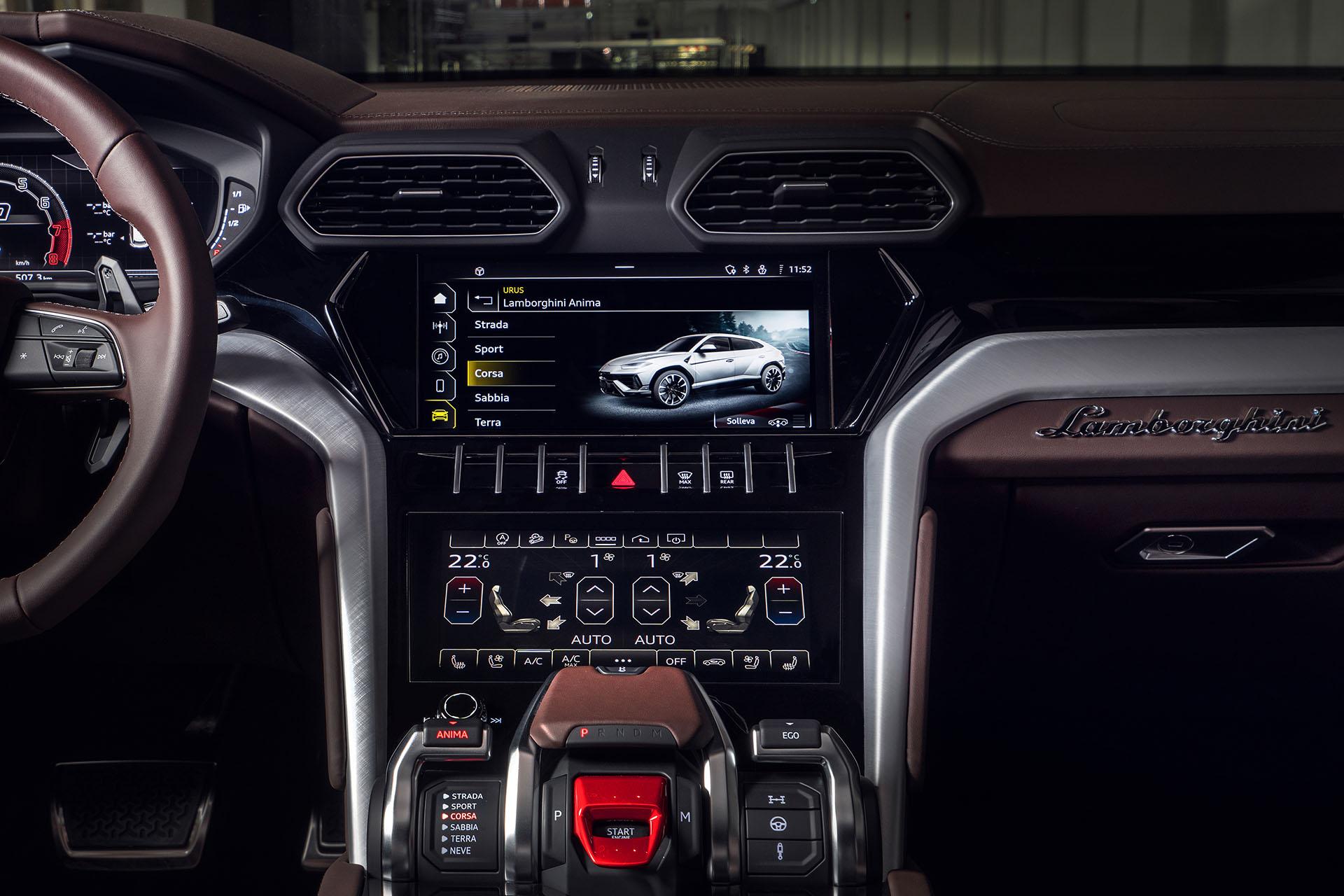
The technology within the Lamborghini Urus emphasizes both performance and luxury. The Lamborghini Infotainment System III (LIS III) provides a dual touchscreen setup for entertainment, navigation, and vehicle settings. The interface design is visually engaging, and the system includes Apple CarPlay and Android Auto compatibility.
The Urus’s ANIMA Selector is a key technological feature, allowing the driver to switch between various driving modes that tailor the vehicle’s performance to different driving conditions. These modes adjust the engine, transmission, suspension, and steering characteristics to offer a unique driving experience.
Driver assistance systems such as adaptive cruise control, lane-keeping assist, and a head-up display offer support and safety on the road. Lamborghini’s emphasis on performance technology also extends to the braking system, where the car benefits from advanced carbon-ceramic brakes for outstanding stopping power.
The optional Bang & Olufsen Sound System offers audio excellence, catering to audiophiles who seek a pristine sound experience.
Price
The Audi RS Q8 is priced within the $114,000 to $120,000 range for its base model in the U.S., positioning it in the premium SUV segment yet being more affordable than the Lamborghini Urus. The final price of the RS Q8 may vary based on customizations and add-ons.
On the other hand, the Lamborghini Urus starts at approximately $220,000 to $230,000 in the U.S., marking its spot as a high-end luxury SUV with performance akin to supercars. The Urus’s price can soar with bespoke customizations and additional features, making it one of the priciest SUVs available.
Conclusion
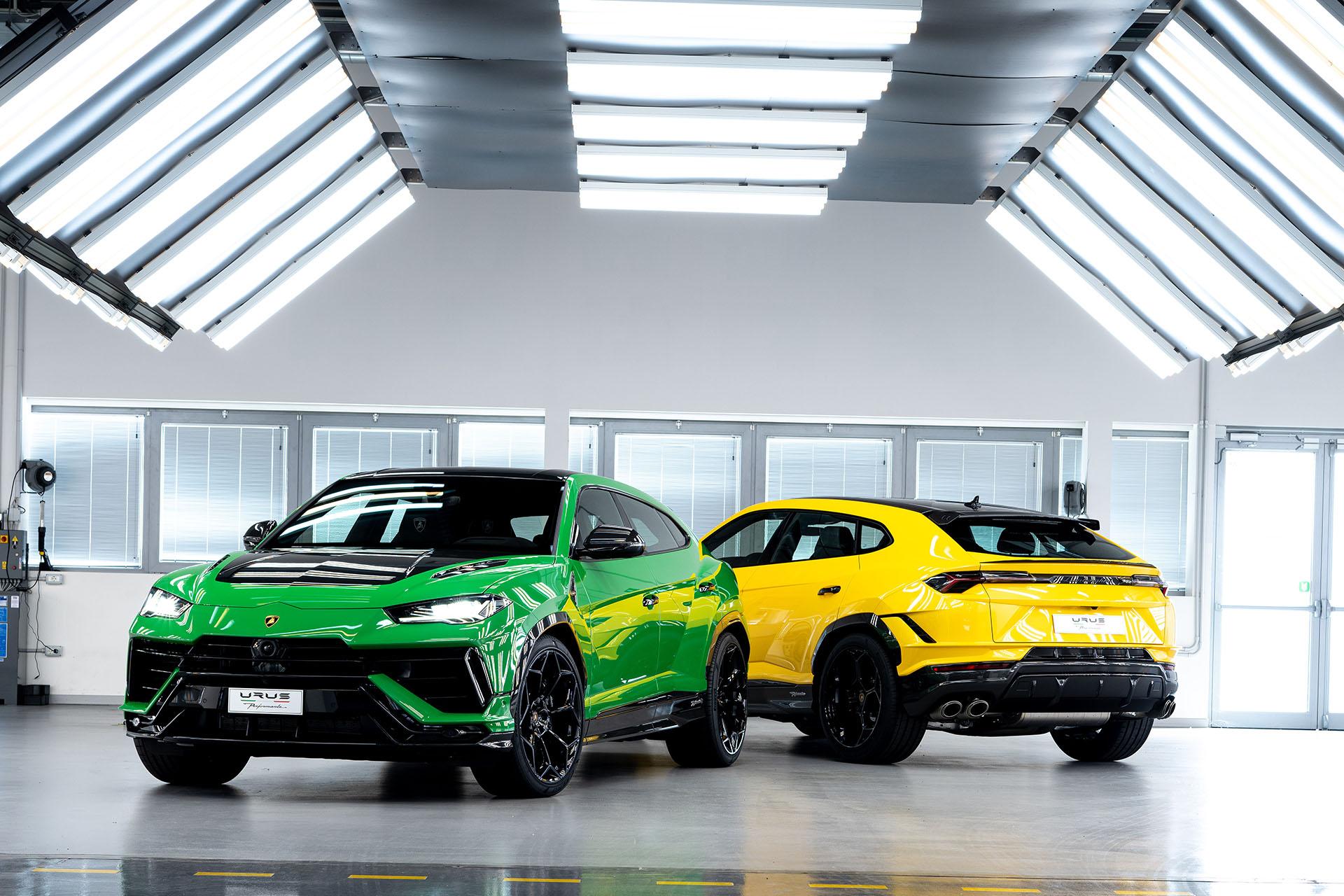
In the face-off between the Lamborghini Urus and the Audi RS Q8, it’s evident that both these vehicles, while rooted in the same Volkswagen family, have charted unique paths in luxury sports SUVs. The Urus, with its audacious design, embodies the unabashed boldness of Lamborghini, offering an exhilarating driving experience with interiors that are nothing short of a theatrical spectacle. On the other hand, the Audi RS Q8 stands as a testament to the brand’s commitment to precision engineering and refined luxury, encapsulating a more understated yet equally powerful presence.
Choosing between the two boils down to personal preference. The Urus is a clear choice if one desires a car that screams attention, offers a blend of luxury with outright audacity, and doesn’t mind shelling out a premium. However, for those who appreciate nuanced elegance, state-of-the-art technology, and a balanced blend of performance with luxury without breaking the bank, the RS Q8 is undeniably compelling.
Both these SUVs have elevated the benchmark in the luxury SUV segment. As they evolve, car enthusiasts and luxury seekers can only expect them to reach newer heights, further blurring the lines between sportiness and luxury.

